In this article, we will look at one of the ways to perform examination exercise Reversing into the box (garage).
The procedure for performing the exercise is reversing into the box (garage)
1. We start the exercise from the START line, move parallel to the line of the AB racks as close as possible to it.
When pillar A is level with the first third of the window (on another car, a mirror can be a reference), we stop (as in exercise, when a certain skill is reached, you can not stop at the intermediate stages of execution).
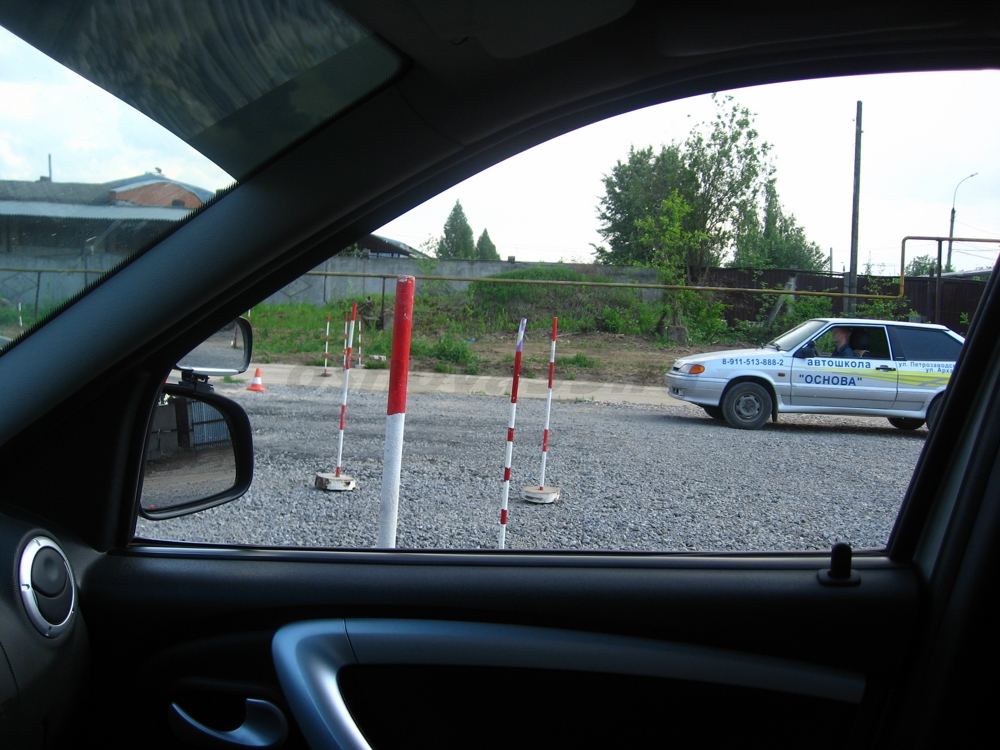
2. Turn the steering wheel to the leftmost position, move with low speed, without crossing the line of cones EF , we stop.
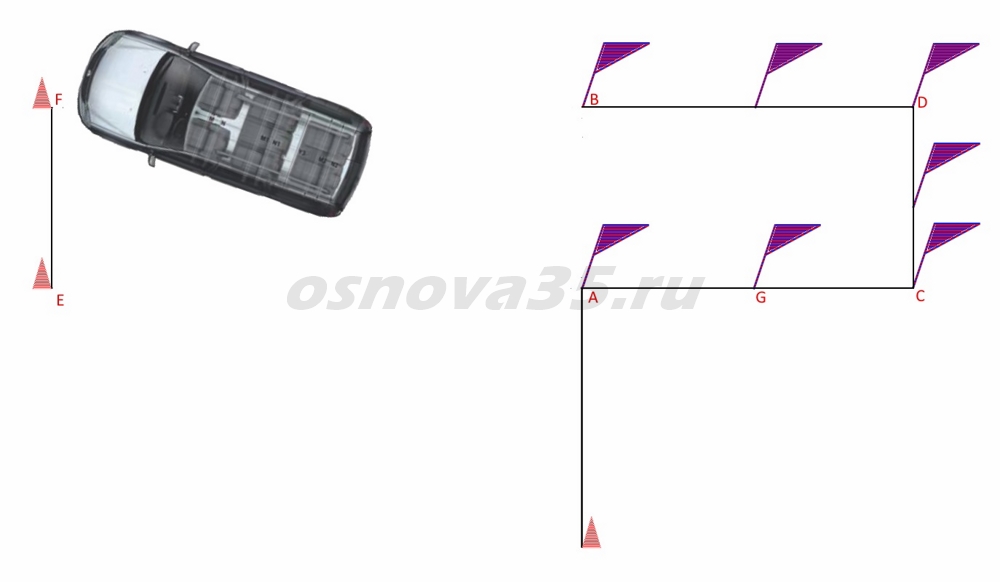
3. Look in side mirrors rear view, we determine on which side the distance from the side line of the car to the first pillars is greater. In the direction of a greater distance, it will be necessary to turn the wheels.
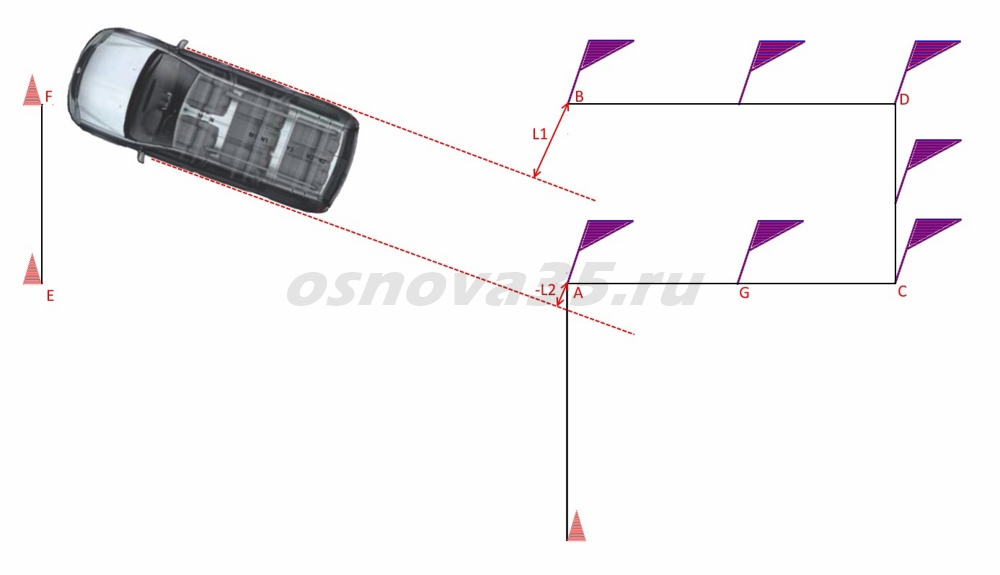
In our case, the distance from the right pillar B is greater, we do not see the pillar A in the left mirror at all.

4. We turn the steering wheel to the extreme right position, slowly move back, when the distances from the side lines of the car to the first pillars on the right and left are the same, we stop.
 Rice. 5
Rice. 5
If the starting position shown in Fig. 2 was successful, then the line of the AC (and BD) pillars will be parallel to the line of the body.

We make the wheels straight, move back until the front dimension of the car crosses the line of the pillars AB, we stop (an auxiliary landmark is the G pillar at the level of the window edge). To put on neutral gear and on the handbrake.
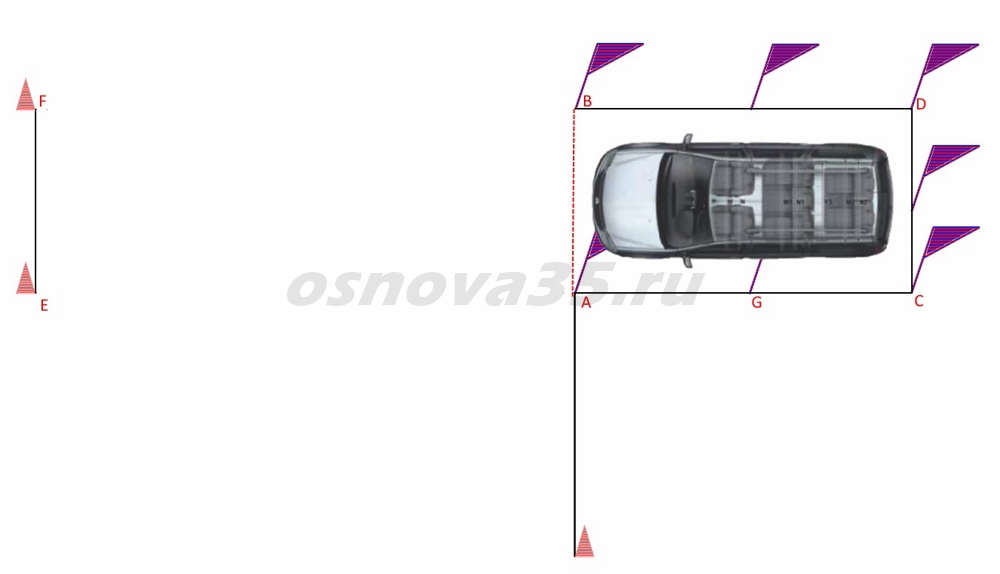 Rice. 6
Rice. 6
If the starting position turned out to be, for example,
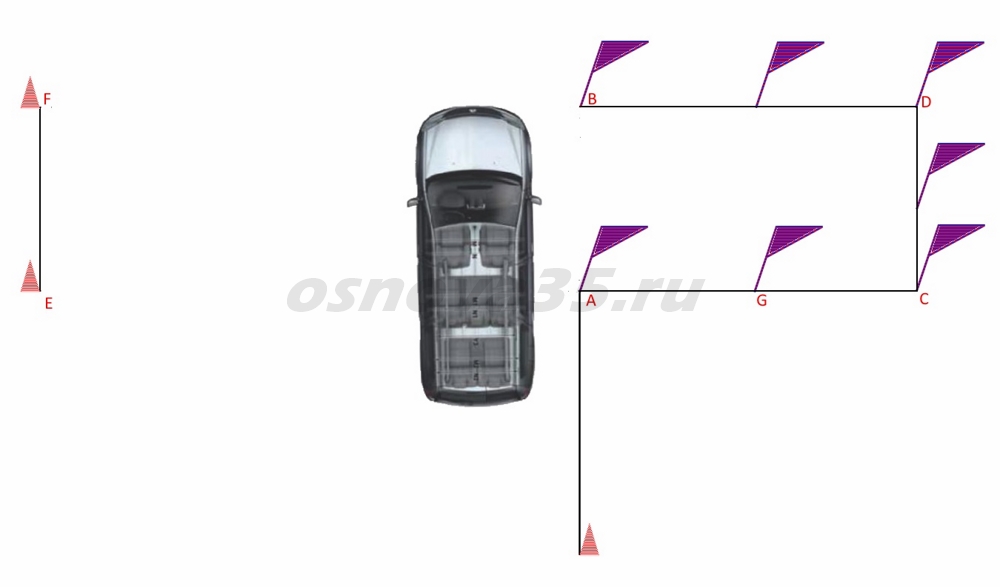
then when moving towards the cones EF, the car will be in this position:
 Rice. 8
Rice. 8
The distance to the right is greater, which means we turn the steering wheel to the right, start moving back, when L1 is equal to L2, we stop.
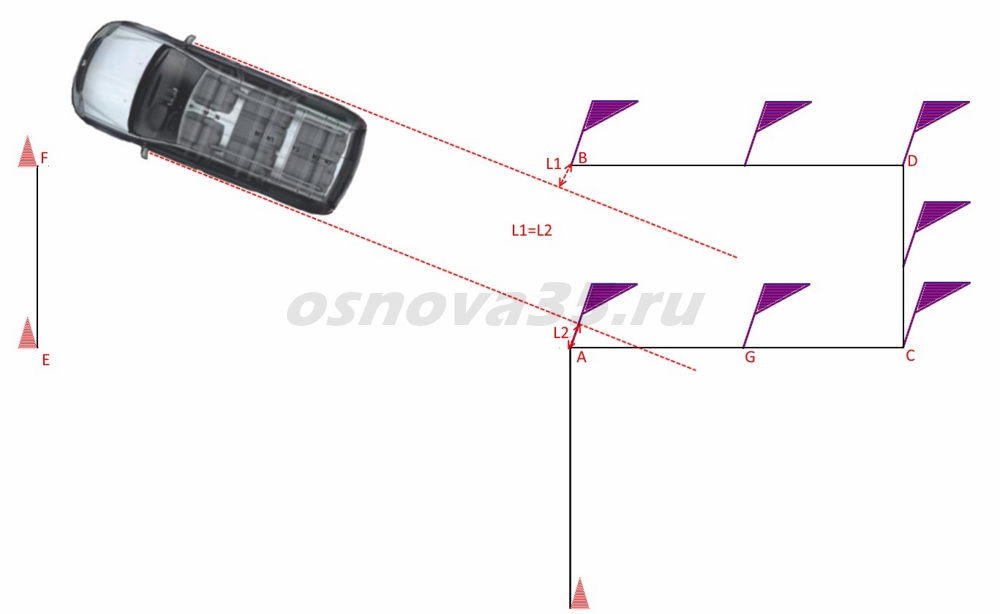 Rice. 9
Rice. 9
Making the wheels straight, moving back until rear wheel will not be on the line of racks AB, we stop.
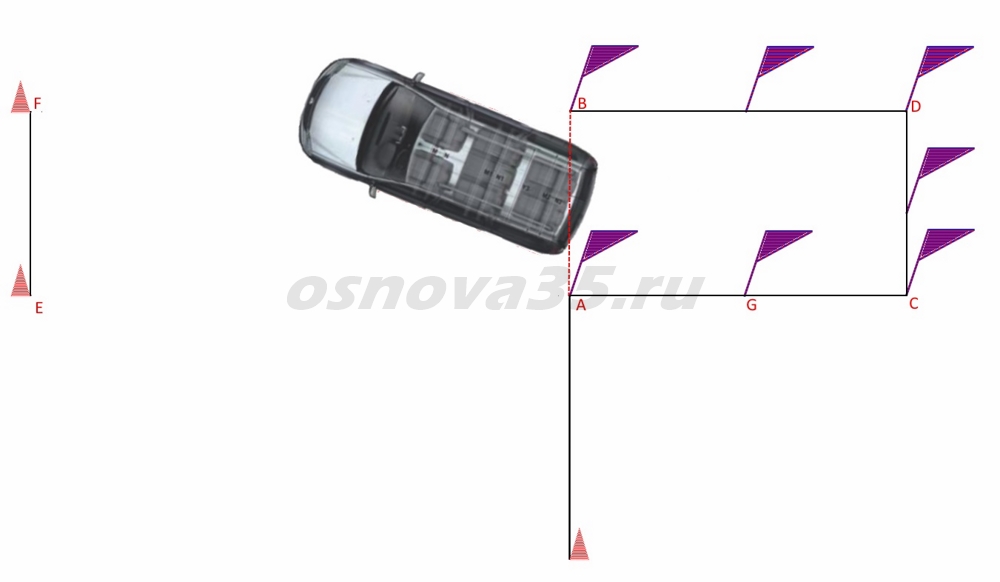 Rice. 10
Rice. 10
We look in the mirrors, determine from which side the distance from the sidewalls of the car to the last C and D pillars is greater in that direction and turn the wheels, in our case to the right. We move back until the car is parallel to the line of the AC pillars,
 Rice. eleven
Rice. eleven
make the wheels straight, finish the exercise.
On the other hand, the exercise Reversing into the box (garage) is performed similarly.
If you see that you do not fit into the box, you can return to the EF cones and repeat the race.
Exam errors in the exercise Reversing into the box (garage)
Gross errors - 5 penalty points
- He knocked down elements of marking equipment or crossed the line of horizontal marking of the site.
- Did not cross the "STOP" line (according to the projection of the front clearance of the vehicle).
Medium errors - 3 penalty points
- Could not enter the box with a one-time transmission reversing.
- Did not shift into neutral after stopping with the engine running.
- Did not include parking brake after stopping at the STOP line.
Minor mistakes - 1 penalty point
- During the exercise, the engine stalled.
Exercise "Snake" on the circuit is not a task high level difficulties, however, not everyone who is just trying to learn how to ride confidently can pass it the first time. Sometimes it also happens that the person driving training car, he is not able to feel the moment of committing a gross mistake. In view of this, going to the circuit, the future motorist will not interfere with a specially designed instruction that will allow you to make the maneuver correctly and accurately.
The scheme of the exercise "snake"
So, the venue for such an exercise is a separate area of the autodrome, which looks like an ordinary rectangle, which is conditionally divided into 4 sections, each of which is 1.5 times longer than body cars. The width of this platform does not exceed the length of the car. The meaning of the exercise is the need for a careful detour of all installed cones that cannot be knocked down. In addition, the driver must not cross the solid lines drawn on the sides.
Exercise rules
To properly make a "snake", you need to know the theoretical foundations that will help the driver. First of all, you need to bring the car closer to the "Start" line and slow down. The site should be crossed according to a certain trajectory, carefully going around everything. Having approached the finish line "Stop", slow down and stop the car.
Penalty points will be awarded for each wrong move, so it is better to perform the snake in stages. For example, for a downed marking element or crossing horizontal lines, the unfortunate driver receives 5 penalty points. If the car crossed the finish line only with the projection of the front clearance - 5 additional points. Three penalty points are awarded:
- for a power unit stalled during the exercise;
- for forgetfulness (after stopping the car with the engine running, the “neutral” was not turned on);
- for the disabled parking brake, which must be brought into working position immediately after stopping the car in front of the finish line.
Step-by-step instructions for the correct execution of the snake
How to drive a snake on the autodrome so as not to earn a single additional penalty point - you need to remember only one valuable advice, which can significantly simplify the delivery of the exercise. A driver who needs to move along a "snake" should in no case use. The movement will be smooth and even if the clutch pedal is carefully released during the approach to the start line, and pressed again just before approaching the stop line.
It is this approach that will tell the driver how to perform the exercise correctly, while the car will go stably, which is why driving along the snake will not cause unnecessary effort and wasted nerves. The main task of the motorist will be only proper management steering device. The only drawback that can prevent the snake from passing is the inability to move on the clutch, this feature can only be due to technical specifications car.

Step-by-step instruction correct execution snake exercises:
- the car should be smoothly brought to the starting line "Start", from which the site begins and stop. Experienced car owners and driving school instructors advise making such an entrance only at a right angle, which helps to significantly simplify the detour of the first marking obstacle;
- then you need to carefully release the clutch pedal to the end and start moving, while the steering wheel should not be turned;
- at the moment when the first chip will be located approximately in the middle of the front door of the car on the driver's side, steering gear it is advisable to turn to the end in left side, and this must be done as quickly as possible;
- having reached the right front corner of the car of the chip to be bypassed, the steering wheel must also be quickly turned all the way to the opposite (right) side;
- in stages, when the left front corner of the car reaches the chip to be bypassed, the steering wheel should be turned to the limit to the other (left) side;
- similarly, it is necessary to bypass all existing obstacles. To drive to the finish line as accurately as possible, you need to turn the steering wheel to the left and press the clutch, while the car will be able to reach the stop line thanks only to inertia.
- at the end of the exercise, the car must be stopped at the finish line with the word "Stop".
Moving on the snake backwards
To perform the snake exercise in reverse, you should know right principle car movements:
- when approaching the first pole, approach the rear left wheel as close as possible, then quickly turn the steering wheel to the left and go around the obstacle;
- looking, at the sight of the next milestone, you need to align the steering device and drive up to the next chip with the right rear wheel;
- the principle of such a movement must be observed until the end of the snake.
The driver must remember that it is necessary to turn the steering wheel and start the maneuver no earlier than the moment when an obstacle appears in the field of view, more precisely, the circled chip should appear in the mirror near one of rear wheels cars.
1.1. The exam is conducted in order to test the driving skills of candidates for drivers of a vehicle of a particular category and determine the possibility of admission to the exam in real conditions. traffic or in cases stipulated by the Rules, making a decision on the possibility of issuing a driver's license.
1.2. During the first stage practical exam the candidate driver is tested for the relevant actions, skills and abilities:
use of vehicle controls, rear-view mirrors;
starting off;
maneuvering in a limited space forward and reverse;
building optimal trajectory maneuver;
estimates of distance, interval, overall parameters TS;
gear shifting;
stops at a designated place;
parking the vehicle parallel to the edge of the carriageway;
entry into the box in reverse;
reversal of 1800 forward and reverse in a limited space;
motorcycle control with one hand;
motorcycle movement on the track board;
driving a motorcycle at low speed;
movement of the road train in a straight line in reverse;
staging the road train with the rear side to the platform.
1.3. The first stage of the practical exam is held on a site closed from traffic or an autodrome (hereinafter referred to as the site) according to the sets of test exercises for a specific category of the vehicle (appendix to the Methodology for conducting the first stage of the practical exam).
1.4. Complexes of test exercises contain:
1.4.1. For candidates for drivers of vehicles of category "A" 3 exercises:
exercise number 1- "overall corridor", "overall semicircle", "acceleration-deceleration";
exercise number 2- "snake", "track board", "low speed control";
exercise number 3- "overall eight";
Note. When taking an examination on a motorcycle with a side trailer, one test exercise is performed, including the following elements:
"snake" (step: 5 m, corridor width: 5 m);
"overall eight" ( outside diameter rings: 8 m, distance between the centers of the rings: 6.5 m);
"acceleration-braking".
1.4.2. For candidates for drivers of vehicles of categories "B", "C" and "D" 3 exercises:
A) option 1:
exercise number 4
exercise number 5
exercise number 6- "snake";
b) option 2:
exercise number 4- "stopping and starting on the rise";
exercise number 5- "parallel parking in reverse";
exercise number 7- "reversal";
V) option 3:
exercise number 4- "stopping and starting on the rise";
exercise number 6- "snake";
exercise number 8- "entrance to boxing".
The option according to which the exam will be conducted is set daily by the head of the examination unit and announced to the driver candidates immediately before the start of the practical exam.
In the event that the size and equipment of the site make it possible to organize an exam for all three options at the same time, it is recommended that the driver candidate be given the opportunity to determine the option for which the exam will be conducted by choosing at random one of the three cards on which the numbers of the corresponding options are indicated.
1.4.3. For candidates for drivers of vehicles of category "E" ("B + E", "C + E", "D + E") 2 exercises:
exercise number 9- "staging to the platform with the tailgate";
exercise number 10- "rectilinear movement in reverse".
1.5. In order to adapt to the examination vehicle (in case the training was carried out on another vehicle), the driver candidate is given the right to make a test drive within the site with a duration of no more than 2 minutes. At the same time, its owner must be present in the examination vehicle (with the exception of category "A" vehicles). Mistakes made during test drive are not recorded and do not affect the result of the exam.
After completing a test drive, a driver candidate may declare that he is not ready and refuse to take the exam.
2. Organization of the exam
2.1. The form of the exam is individual. The exam can be taken from one or more candidates for drivers at the same time.
2.2. The first stage of the practical exam is conducted by one of two methods:
A) one driver candidate performs in a certain sequence all the exercises provided for by the complex. In this case, the candidate driver, without stopping the engine and without leaving the vehicle, informs the examiner about the completion of one exercise and readiness to perform the next one;
b) several candidates for drivers alternately perform one exercise provided for by the complex, and then proceed to the next exercise.
The method of conducting the exam is selected depending on the material and technical equipment of the examination unit, the arrangement and size of the site, the number of examiners, the examined and used examination vehicles.
2.3. The sequence of performing the exercises provided by the complex for a particular category of vehicle is determined by the examiner.
2.4. Exercises No. 1 - 4 are performed only on a vehicle with a mechanical transmission.
Note. When conducting an exam for obtaining the right to drive a vehicle of category "D", it is allowed to perform exercise No. 4 on a vehicle with automatic transmission.
2.5. The vehicle must comply traffic rules and Basic provisions for the admission of the vehicle to operation.
Serviceable technical condition The vehicle must be confirmed by an appropriate document on passing the state technical inspection.
Before starting the exercise, the vehicle must be installed in the pre-start zone, the engine warmed up and stopped, the gear lever in neutral position, the parking brake on.
2.6. The exam is held at a site that meets the following requirements:
the site must be equipped in accordance with the exercise schemes (appendix to the Methodology for conducting the first stage of the practical exam);
for exercise No. 4 "Stopping and starting on the rise", the use of a track overpass is not allowed; the inclined section must have a longitudinal slope within 8-16% inclusive;
the surface of the site must be even and uniform;
the friction coefficient of the wheel with the surface of the site (including the inclined section) must be at least 0.4;
in the event of an examination in dark time day illumination area should be at least 20 lux.
2.7. Exam is not allowed:
if the vehicle does not meet the requirements set out in clause 2.5 of this Methodology;
if the site does not meet the requirements set out in clause 2.6 of this Methodology.
2.8. Control during the performance of exercises is carried out by the examiner visually or with the help of technical means.
Representatives of educational, transport institutions (enterprises), military commissariats and other organizations (hereinafter referred to as the assistant) may be involved to assist in the examination.
3. Exam procedure
3.1. The examiner acquaints the driver candidate with the form, method, procedure for conducting the exam, the assessment system and suggests performing the exercises in a certain sequence, provided for by the complex for a particular category of vehicle.
3.2. According to the examiner's commands, the candidate driver takes a place in the examination vehicle, prepares for the movement and performs the exercise.
3.3. During the exam, the examiner controls the progress of the task, keeps time, gives commands to the driver candidate, classifies using the checklist and fixes errors in the examination sheet, sums up the number of penalty points scored by the driver candidate and sets a mark for the performance of each exercise and the exam as a whole . The examiner ensures compliance general requirements site safety during the exam.
Commands to the candidate driver must be given clearly and in a timely manner. If it is not possible to give voice commands (the examiner is outside the start area), the examiner can use the system conditional gestures, the values of which are previously brought to the attention of the driver candidate.
3.4. The examination sheet with the results of the exam is signed by the examiner, and then by the driver candidate.
4. Grading system
4.1. The final mark is set on the basis of marks for the performance of all exercises provided by the complex for a particular category of vehicle.
4.2. The correctness of the task of each exercise is evaluated according to the system: a positive assessment is "COMPLETE", a negative one - "NOT COMPLETE".
For each exercise there is a list common mistakes, which are divided into coarse, medium and fine. In accordance with this classification, for making each mistake, the candidate driver is awarded penalty points: for rough - 5, for medium - 3, for small - 1.
Checklists, including lists of typical mistakes and scales of penalty points for the mistakes made, are given in the appendix to the Methodology for conducting the first stage of the practical exam.
The score "COMPLETED" is given when the driver candidate did not make any mistakes during the exercise or the amount of penalty points for the mistakes made is less than 5.
The mark "NOT PERFORMED" is given when the amount of penalty points for the mistakes made is 5 or more.
4.3. The final grade "PASSED" for the first stage of the practical exam is set if the driver candidate has received the grade "PASSED" for all the exercises provided for by the complex for a particular category of vehicle.
4.4. The final mark "NOT PASSED" is given if the driver candidate refused to perform the exercise or received the mark "NOT PERFORMED" for two exercises out of all provided by the complex.
4.5. In the event that a candidate for drivers received the mark "NOT COMPLETED" for one exercise out of all provided for by the complex, he is given a one-time opportunity to re-perform this exercise. The number of the exercise performed repeatedly is indicated on the examination sheet.
With a positive result of the repetition of the exercise for the first stage of the practical exam, the final grade "PASSED" is given to the driver candidate, if the result is negative - "DO NOT PASS".
Appendix to the methodology for conducting the first stage of the practical exam
Test exercises for the first stage of the practical exam
List of symbols
1. Exercise No. 1 "Dimensional corridor", "dimensional semicircle", acceleration-deceleration"
1.1. Content.
Movement in the "outline corridor", hand signaling a left turn (reversal), movement along the "outline semicircle" trajectory, shifting gears when driving in a straight line from lower to higher and from higher to lower, giving a brake signal by hand, stopping in front of the "STOP" line "(Fig. 1).
1.2.
1.2.1.
prepare for the move
start the engine;
turn on the low beam headlights.
1.2.2.
movement in the "overall corridor", advance (before passing the middle of the corridor) giving a left turn (reversal) signal by hand;
movement along the trajectory "overall semicircle";
driving in a straight line, shifting gears from lower to higher and from higher to lower;
giving a brake signal by hand, smooth braking, stop at a distance of not more than 0.4 m before the "STOP" line.
1.2.3.
turn off the headlights;
turn off the engine;
dismount from a motorcycle;
1.3. actions of the examiners.
The examiner controls the correctness of the assignment using the checklist No. 1 and marks the exercise.
During the exercise, the examiner controls the zones of start, acceleration, braking, stopping, and his assistant - the zone of the "overall corridor" and "overall semicircle".
Rice. 1. Exercise No. 1 "Dimensional corridor", "dimensional semicircle", acceleration-deceleration" Checklist #1
Common Mistakes | |
A. Rough |
|
did not signal a left turn (reversal) by hand - | |
stopped at a distance of more than 0.4 m in front of the STOP line or crossed it - | |
B. Medium |
|
gave a hand signal for a left turn (reversal) after passing through the middle of the "outline corridor" - | |
did not shift gear from lower to higher or from higher to lower - | |
B. small |
|
did not give a brake signal by hand - | |
produced hard braking(allowed the wheel to lock) in front of the "STOP" line - | |
2. Exercise number 2 "Snake", "rut board", movement at low speed"
2.1. Content.
Movement along the "snake" trajectory, movement along the "rut board", movement at low speed (Fig. 2).
2.2. Assignment to the driver candidate.
2.2.1. At the command of the examiner, the candidate driver must:
take a seat on a motorcycle in the pre-launch area;
prepare for the move
start the engine;
take the starting position in front of the "START" line;
turn on the low beam headlights.
2.2.2. At the command of the examiner, the candidate driver must perform
starting off at the starting gate;
movement along the "snake" trajectory, going around the first cone on the right;
movement along the "rut board";
movement in the "dimensional corridor" at low speed for a time of at least 5 s;
2.2.3. After stopping the motorcycle, the candidate driver must:
turn on neutral gear;
turn off the headlights;
turn off the engine;
dismount from a motorcycle;
install the motorcycle in the pre-launch area.
2.3. actions of the examiners.
The examiner controls the correctness of the assignment using the checklist No. 2 and marks the exercise.
During the exercise, the examiner controls the start zone, the "clear corridor" for movement at low speed, stops, clocks the time of movement in the "clear corridor", and his assistant - the zone of the "clear snake", "rut board", gives a signal to start timing time.
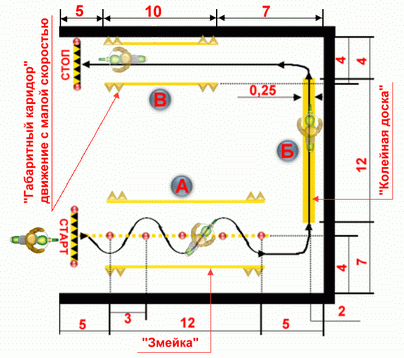
Fig.2. Exercise #2<"Змейка", "колейная доска", движение с малой скоростью> Checklist #2
Common Mistakes | Error penalty scale |
A. Rough |
|
deviated from the given trajectory of movement - | |
knocked down elements of marking equipment or crossed the line of horizontal marking of the site - | |
touched the surface of the platform with the foot during the exercise - | |
crossed the line "STOP" - | |
B. Medium |
|
when starting off at the starting gate, the engine stalled - | |
did not turn on the neutral gear after stopping with the engine running - | |
B. small |
|
did not turn on the low beam headlights - | |
3. Exercise number 3 "Dimensional eight"
3.1. Content.
Movement along the "overall eight" trajectory (Fig. 3).
3.2. Assignment to the driver candidate.
3.2.1. At the command of the examiner, the candidate driver must:
take a seat on a motorcycle in the pre-launch area;
prepare for the move
start the engine;
take the starting position in front of the "START" line;
turn on the low beam headlights.
3.2.2. At the command of the examiner, the candidate driver must perform:
starting off at the starting gate;
movement along the "overall eight" trajectory;
stop before the STOP line.
3.2.3. After stopping the motorcycle, the candidate driver must:
turn on neutral gear;
turn off the headlights;
turn off the engine;
dismount from a motorcycle;
install the motorcycle in the pre-launch area.
3.3. Examiner actions.
The examiner controls the correctness of the assignment using the checklist No. 3 and marks the exercise.
During the exercise, the examiner controls the stop zone, the "overall eight", and his assistant controls the start zone.

Rice. 3. Exercise number 3 "Dimensional eight" Checklist #3
Common Mistakes | Error penalty scale |
A. Rough |
|
deviated from the given trajectory of movement - | |
knocked down elements of marking equipment or crossed the line of horizontal marking of the site - | |
touched the surface of the platform with the foot during the exercise - | |
crossed the line "STOP" - | |
B. Medium |
|
when starting off at the starting gate, the engine stalled - | |
did not comply with the time limit when moving in the "overall corridor" at low speed - | |
did not turn on the neutral gear after stopping with the engine running - | |
B. small |
|
did not turn on the low beam headlights - | |
4. Exercise number 4 "Stopping and starting off on the rise"
4.1. Content.
Driving on an inclined section, stopping on an inclined section in front of the "STOP-1" line, starting off on an inclined section, stopping in front of the "STOP" line (Fig. 4).
4.2. Assignment to the driver candidate.
4.2.1. At the command of the examiner, the candidate driver must:
take a seat in the vehicle;
prepare for the move
start the engine.
4.2.2. At the command of the examiner, the candidate driver must perform:
starting off at the starting gate;
movement on an inclined section;
stopping in front of the "STOP-1" line (sign) in such a way that all the wheels of the vehicle are on an inclined section;
fixing the vehicle in a stationary state (parking or service brake);
starting off on an inclined section, preventing the vehicle from rolling back by an amount exceeding the control interval;
stop before the STOP line.
4.2.3.
turn on neutral gear;
apply the parking brake;
turn off the engine;
4.3. actions of the examiners.
The examiner controls the correctness of the assignment using the checklist No. 4 and marks the exercise.
During the exercise, the examiner controls the start and stop zones in front of the STOP-1 line, fixes the rollback, and his assistant controls the stop zone in front of the STOP line.

Rice. 4. Exercise number 4 "Stopping and starting off on the rise"
Common Mistakes | Error penalty scale |
A. Rough |
|
knocked down elements of marking equipment or crossed the line of horizontal marking of the site - | |
did not fix the vehicle in a stationary state when stopping on an inclined section - | |
allowed the vehicle to roll back when starting on an inclined section of more than the value L - | |
B. Medium |
|
crossed the line "STOP-1" (according to the projection of the front clearance of the vehicle) when stopping on an inclined section - | |
did not turn on the neutral gear after stopping with the engine running - | |
Exceeding the allowable rollback value is fixed as follows: after the vehicle stops at the "STOP-1" line at a distance L from rear bumper(sides) a control rack is installed. If, when starting the vehicle on an inclined section, the amount of rollback exceeds the allowable value, the rack will be knocked down.
The value of the control interval L (in meters) is determined by the formula: L=0.0125a+0.1, where a is the value of the longitudinal slope (in percent).
5. Exercise number 5 " Parallel parking in reverse"
5.1. Content.
Parking the vehicle in reverse parallel to the imaginary edge of the carriageway (Fig. 5).
5.2. Assignment to the driver candidate.
5.2.1. At the command of the examiner, the candidate driver must:
take a seat in the vehicle;
prepare for the move
start the engine.
5.2.2. At the command of the examiner, the candidate driver must perform:
starting off at the starting gate;
entrance to the parking area along a given trajectory;
stop in the parking area in front of the STOP line.
Note. After stopping, the vehicle must be completely in the parking area, limited by racks and a broken marking line.
5.2.3. After stopping the vehicle, the candidate driver must:
turn on neutral gear;
apply the parking brake;
turn off the engine;
leave the vehicle.
5.3. Examiner actions.
The examiner controls the correctness of the assignment using the checklist No. 5 and marks the exercise.
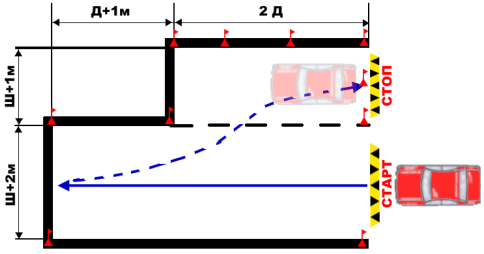
Rice. 5. Exercise number 5 "Parallel parking in reverse Checklist #5
Common Mistakes | Error penalty scale |
A. Rough |
|
knocked down elements of marking equipment or crossed the line of horizontal marking of the site - | |
did not cross the broken line (according to the projection side clearance TS) - | |
B. Medium |
|
could not enter the parking area with a one-time reverse gear - | |
did not turn on the neutral gear after stopping with the engine running - | |
did not apply the parking brake after stopping in the parking zone - | |
B. small |
|
during the exercise, the engine stalled - | |
6. Exercise number 6 "Snake"
6.1. Content.
Driving along the "snake" trajectory (Fig. 6).
6.2. Assignment to the driver candidate.
6.2.1. At the command of the examiner, the candidate driver must:
take a seat in the vehicle;
prepare for the move
start the engine.
6.2.2. At the command of the examiner, the candidate driver must perform:
starting off at the starting gate;
movement along a given trajectory;
stop before the STOP line.
6.2.3. After stopping the vehicle, the candidate driver must:
turn on neutral gear;
apply the parking brake;
turn off the engine;
leave the vehicle.
6.3. actions of the examiners.
The examiner controls the correctness of the assignment using the checklist No. 6 and marks the exercise.
During the exercise, the examiner controls the "snake" and stop zones, and his assistant controls the start zone.

Rice. 6. Exercise number 6 "Snake" Checklist #6
7. Exercise number 7 "Turn"
7.1. Content.
Turn the vehicle 180° in a space limited in width, stop in front of the "STOP" line (Fig. 7).
7.2. Assignment to the driver candidate.
7.2.1. At the command of the examiner, the candidate driver must:
take a seat in the vehicle;
prepare for the move
start the engine.
7.2.2. At the command of the examiner, the candidate driver must perform:
starting off at the starting gate;
reversal along a given trajectory with a one-time reverse gear engagement;
stop before the STOP line.
7.2.3. After stopping the vehicle, the candidate driver must:
turn on neutral gear;
apply the parking brake;
turn off the engine;
leave the vehicle.
7.3. Examiner actions.
The examiner controls the correctness of the assignment using the checklist No. 7 and marks the exercise.
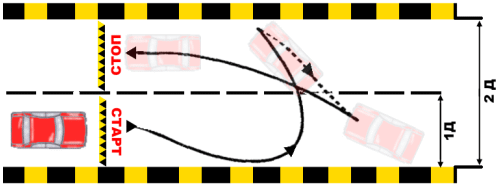
Rice. 7. Exercise number 7 "Turn" Checklist #7
Common Mistakes | Error penalty scale |
A. Rough |
|
knocked down elements of marking equipment or crossed the line of horizontal marking of the site - | |
crossed the "STOP" line (according to the projection of the front clearance of the vehicle) - | |
B. Medium |
|
could not turn around with a one-time reverse gear - | |
did not turn on the neutral gear after stopping with the engine running - | |
did not apply the parking brake after stopping in front of the "STOP" line - | |
B. small |
|
during the exercise, the engine stalled - | |
8. Exercise number 8 "Entering the box"
8.1. Content.
Entrance to the box in reverse (Fig. 8).
8.2. Assignment to the driver candidate.
8.2.1. At the command of the examiner, the candidate driver must:
take a seat in the vehicle;
prepare for the move
start the engine.
8.2.2. At the command of the examiner, the candidate driver must perform:
starting off at the starting gate;
entry into the box along a given trajectory;
stop before the STOP line.
8.2.3. After stopping the vehicle, the candidate driver must:
turn on neutral gear;
apply the parking brake;
turn off the engine;
leave the vehicle.
Note. Entry into the box can be carried out from the initial position, both on the right and on the left side of the box at the choice of the driver candidate.
8.3. actions of the examiners.
The examiner controls the correctness of the assignment using the checklist No. 8 and marks the exercise.
During the exercise, the examiner controls the stop zone in front of the STOP line, the position of the vehicle in the box, and his assistant controls the start zone.

Rice. 8. Exercise number 8 "Entering the box" Checklist #8
Common Mistakes | Error penalty scale |
A. Rough |
|
knocked down elements of marking equipment or crossed the line of horizontal marking of the site - | |
crossed the "STOP" line (according to the projection of the front clearance of the vehicle) - | |
B. Medium |
|
could not enter the box with a one-time reverse gear - | |
did not turn on the neutral gear after stopping with the engine running - | |
did not apply the parking brake after stopping in front of the "STOP" line - | |
B. small |
|
during the exercise, the engine stalled - | |
9. Exercise number 9 "Setting to the platform with the back side"
9.1. Content.
Positioning the trailer with the tailgate to the loading platform simulator (Fig. 9).
9.2. Assignment to the driver candidate.
9.2.1. At the command of the examiner, the candidate driver must:
take a seat in the vehicle;
prepare for the move
start the engine.
9.2.2. At the command of the examiner, the candidate driver must perform:
entrance to the "overall corridor" in reverse;
tailgate access to the loading platform simulator (row of racks);
stop at a distance of no more than 5% of the road train length in front of the loading platform simulator.
9.2.3. After stopping the vehicle, the candidate driver must:
turn on neutral gear;
apply the parking brake;
turn off the engine;
leave the vehicle.
9.3. actions of the examiners.
The examiner controls the correctness of the assignment using the checklist No. 9 and marks the exercise.
During the exercise, the examiner controls the zones of the "overall corridor", stops in front of the loading platform simulator, and his assistant controls the zone
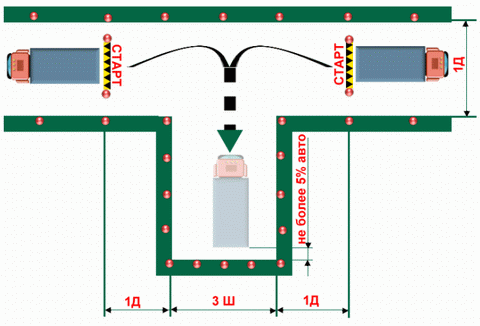
Rice. 9. Exercise number 9. "Setting to the platform with the rear side" Checklist #9
Common Mistakes | Error penalty scale |
A. Rough |
|
knocked down elements of marking equipment or crossed the line of horizontal marking of the site - | |
stopped at a distance of more than 1.5 m in front of the loading platform simulator - | |
B. Medium |
|
could not enter the corridor with a one-time reverse gear - | |
stopped at a distance of more than 5% of the road train length, but not more than 1.5 m in front of the loading platform simulator - | |
did not turn on the neutral gear after stopping with the engine running - | |
did not apply the parking brake after stopping in front of the "STOP" line - | |
B. small |
|
during the exercise, the engine stalled - | |
10. Exercise number 10 "Rectilinear reversing"
10.1. Content.
Movement in the "overall corridor" in reverse, stopping in front of the "STOP" line (Fig. 10).
10.2. Assignment to the driver candidate.
10.2.1. At the command of the examiner, the candidate driver must:
take a seat in the vehicle;
prepare for the move
start the engine.
10.2.2. At the command of the examiner, the candidate driver must perform:
starting in reverse at the starting gate;
movement in a straight line in the "dimensional corridor" in reverse;
stop before the STOP line.
10.2.3. After stopping the vehicle, the candidate driver must:
turn on neutral gear;
apply the parking brake;
turn off the engine;
leave the vehicle.
10.3. Examiner actions.
The examiner controls the correctness of the assignment using the checklist No. 10 and marks the exercise.
During the exercise, the examiner controls the "outline corridor" zones, stops in front of the "STOP" line, and his assistant controls the start zone.

Rice. 10. Exercise number 10 "Rectilinear reversing" Checklist #10
Common Mistakes | Error penalty scale |
A. Rough |
|
knocked down elements of marking equipment or crossed the line of horizontal marking of the site - | |
could not pass the overall corridor with a one-time reverse gear - | |
did not cross the "STOP" line (according to the projection of the front clearance of the vehicle) - | |
B. Medium |
|
did not turn on the neutral gear after stopping with the engine running - | |
did not apply the parking brake after stopping in front of the "STOP" line - | |
B. small |
|
during the exercise, the engine stalled - | |
3. Methodology for the first stage of the practical exam (on the circuit)







